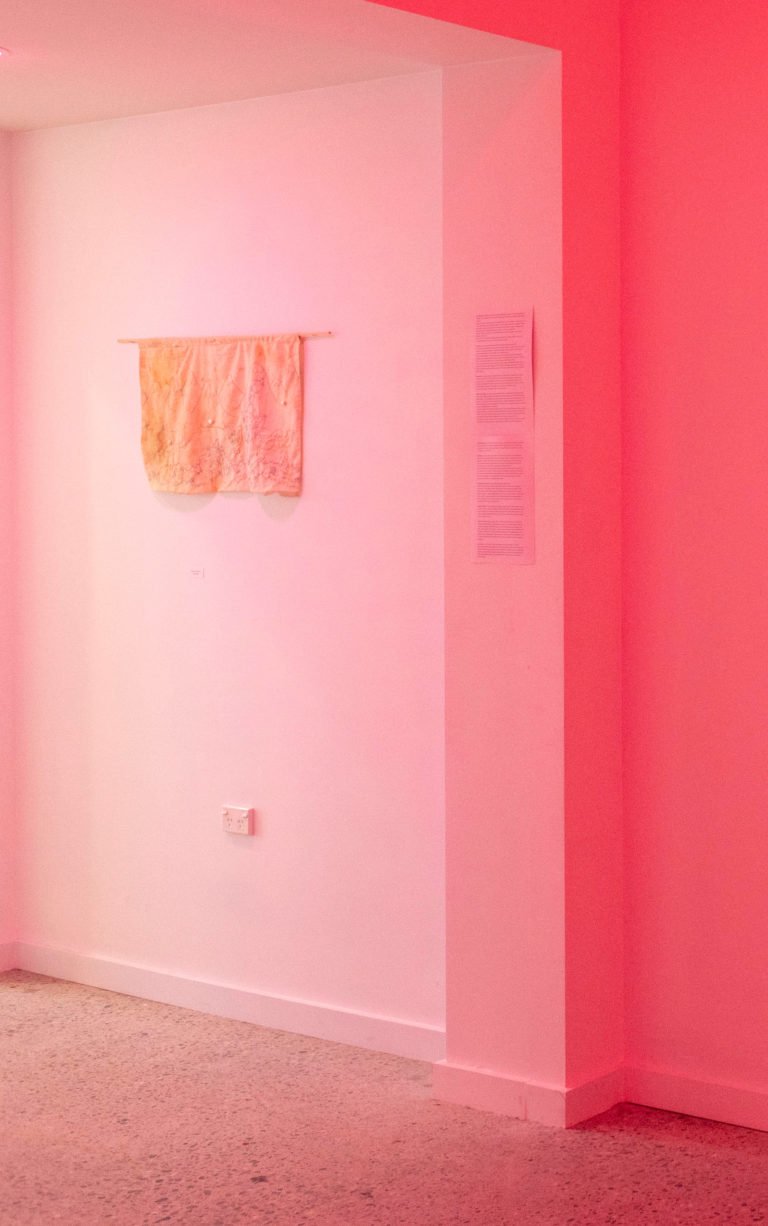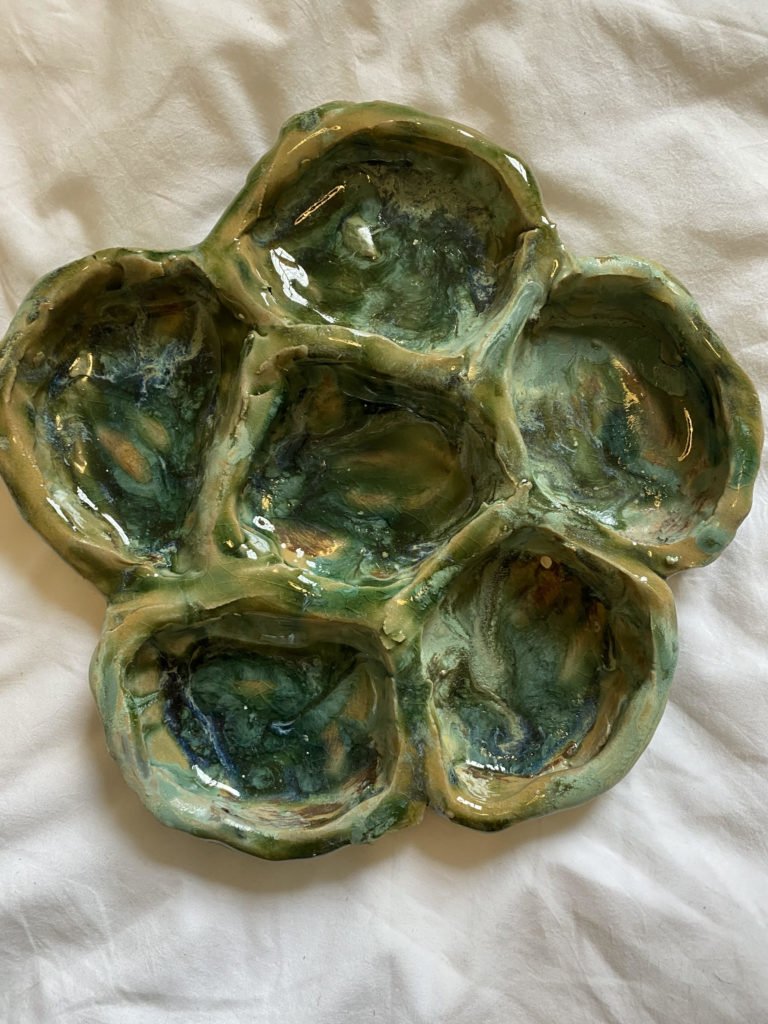Hana Pera Aoake in conversation with Wesley John Fourie
All is Full of Love is a group exhibition at Broker in Queenstown. Here, curator Wesley John Fourie speaks to artist Hana Pera Aoake about her contribution and wider visual artistic practice.
Wesley John Fourie: Could you start by talking a little bit about the work you've presented in this exhibition, All is Full of Love?
Hana Pera Aoake: Kia ora Wes. First of all, thank you for working with me, and for the way you always awhi me with generosity as a friend and as an artist. I made an embroidery from fabric I dyed with Harakeke from my parents’ old home in Waikouaiti as well as Kawakawa that I collected in secret places around Ootepoti. I sometimes draw and sometimes freehand stitch onto fabric. I started sewing last year in lockdown when my grandmother died.I wanted to make something that spoke to the Kai Tahu creationism story, which differs from other genealogical stories from Te Ika-a-Maaui (the North Island). This is why I mentioned Te Waka-o-Aoraki, which is another name for the South Island alongside Ka Tiritiri o te Moana, the name for the Southern Alps.
Hana Pera Aoake, Ko Aoraki te mauka, 2021, thread, freshwater pearls, paua shell on harakeke & kawakawa dyed cotton, wooden rod. Installation view, All is Full of Love, curated by Wesley John Fourie, Broker Galleries, Queenstown, August 2021
I love the use of mixed media in this piece, particularly the pearls. Some of your work is highly informed by the materials (trinkets, plant matter, pigments, etc) you gather across Aotearoa, and I wonder if you could talk about how the use of natural materials shapes what the artwork will become?
I’ve always used dirt, clay and plants in my work even when I used to just make performance. I have hoarded rocks, dirt, sticks, lichen, plastic rubbish, shells and such since childhood. I love being in my mara and growing plants. Usually I try and figure out how to mix things I have found with more traditional art materials or they just sit in my studio as ornaments. I never really know how they will turn out or what will happen, especially using native plants for dyeing or found clay for glazes, paints and pottery firings. I guess that’s why I like to use these materials… It’s an experiment.It’s also a way or process of acknowledging the relationship between human and non-human biologies, living and non-living entities and so forth. I think a lot about how just about everything we use is the result of another’s life and/or labour. I think we should all be, human or no, bound to a reciprocal relationship that’s based around gratitude and care, so kaitiakitanga. It’s acknowledging that the fabric I am sewing on was a plant that was then spun into a thread to make a textile that I then bought from an op shop, that had another purpose in someone else’s care before that. I don’t mean to sound hippy dippy but it’s nice to not feel so divorced from the materials we use to make art.
Here you've presented us with a work that speaks to the whakapapa of Ka Tiritiri o te Moana, the Southern Alps, how do you feel our natural world informs your practice?
I’ve spent a lot of time in central Otago since coming home to Aotearoa, especially in Waanaka. I used to go camping there every summer with my whaanau in Glendhu Bay. I’ve been learning a lot about Ngaati Waewae (Kaai Tahu) whakapapa on my matrilineal side, which I never really knew much about until my grandfather passed away in 2017. I always loved it here and felt at ease here but never fully clicked until I started to look into the whakapapa. Ka Tiritiri o te Moana is my tuupuna and tuupuna to all the tangata of the South Island.I love the mountains and how Ka Tiritiri-o-te-Moana cuts through most of the South Island. I think we have spoken recently about how humbling and reassuring it is to feel so small amongst these otherworldly maunga. I love the braided riverways, lakes and other bodies of water are fed off of these mountains. They look like veins and I imagine them filled with taniwha and tuna (eels).
On the day of the opening, you pointed out to me how amazing the work smells due to dying it with kawakawa, and I remember commenting to you in your studio a while back about a beeswax piece smelling lovely too. It's nice that your work evokes another of our senses, it really activates the viewer’s response by incorporating this other element. Do you want toa speak about your decision in selecting material and how it really informs its environment in space, whilst also commenting on the environment it came from?
I like it when art smells nice or has an aroma, because it is so tied to memory and in some ways offers other ways of seeing and experiencing the world. I like to use a lot of natural materials like plants and beeswax, because the smell isn’t toxic. I use Kawakawa a lot because it’s rongoa, it’s a healing plant that is tapu and noa. It’s used for ailments like scratches, rashes, a sore puku etc, but also in ceremony, like during tangi. It can be used as a dye, in tea, as a balm or oil or in the bath or adornment. I follow tikanga that I learnt from my Uncle when using it, which just involves saying a Karakia when I pick it and when I boil it into a dye. Again it’s just another way of showing kaitiakitanga and developing a relationship based on reciprocity with other living beings. Maaori from different areas have their own tikanga around using it, but that’s what I have always practiced.
Yourself, Taarn [Scott], and I have a few collaborative projects coming up together, and I really enjoy the soft linkages between our three diverse practices. As someone who works with such personal content, how do you find working with others in an art environment?
I don’t like to show alone. I don’t think I’ve ever done it before, every ‘solo’ show I’ve had has ended up being collaborative. Sometimes I worry it’s out of fear, which it might be too, but it’s also maybe because of being raised in a big whaanau and having to share with lots of siblings. Being raised in a Maaori whaanau has always been about sharing and connecting with others. I do think individuality is something that’s important, to be nurtured and celebrated, because we have to carry our own ideas, gifts and perspectives with conviction in order to be able to share with others.Perhaps the very nature of making work that is personal means you are more open to sharing space and time with others. I love showing with you and Taarn, our work is all so different, but we all have a sense of experimenting with materials, of care for what we are doing; and imbue our work with a mauri or agency that reflects our differences as people but also ties our work together.
Hana Pera Aoake, My love for you is endless, 2021, expanding foam, wool, shells, rocks, fishing line, fishing rope, kina shell, pearls, ribbon, house paint, dried jellyfish, paper, beeswax, chemical pigment on found glass frame. Courtesy of the artist
Hana Pera Aoake, WIP, 2020–present, thread on kawakawa dyed cotton. Courtesy of the artist
Hana Pera Aoake, Maumahara (Wiri and Pera), 2020, woven Tī kouka, Kōrari, Kōwhai, lichen, Pīngao, inkjet photograph, and beeswax on glass. Courtesy of the artist
Hana Pera Aoake, Tio (for Nana Jean), 2021 fired uku from Karangahape road & Nelson with glaze and found glass. Courtesy of the artist
All is Full of Love, curated by Wesley John Fourie, Broker, Queenstown, August–September 2021
RELATED READING
Wesley John Fourie interviews other exhibition artists Alice Alva and Taarn Scott





